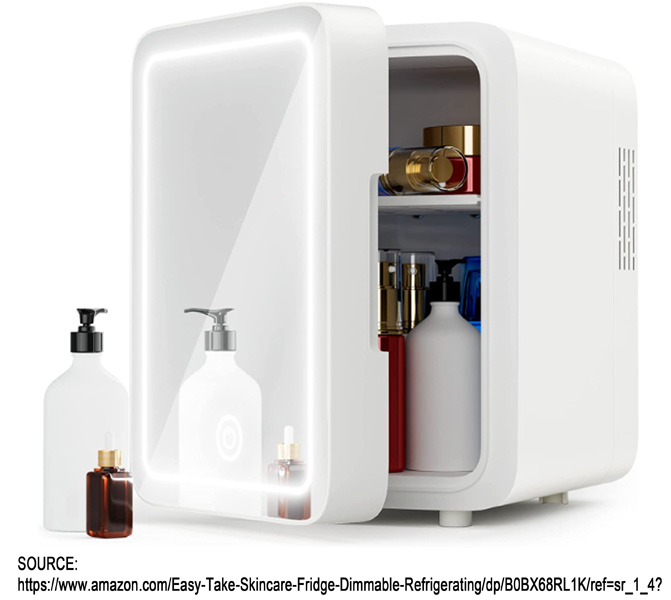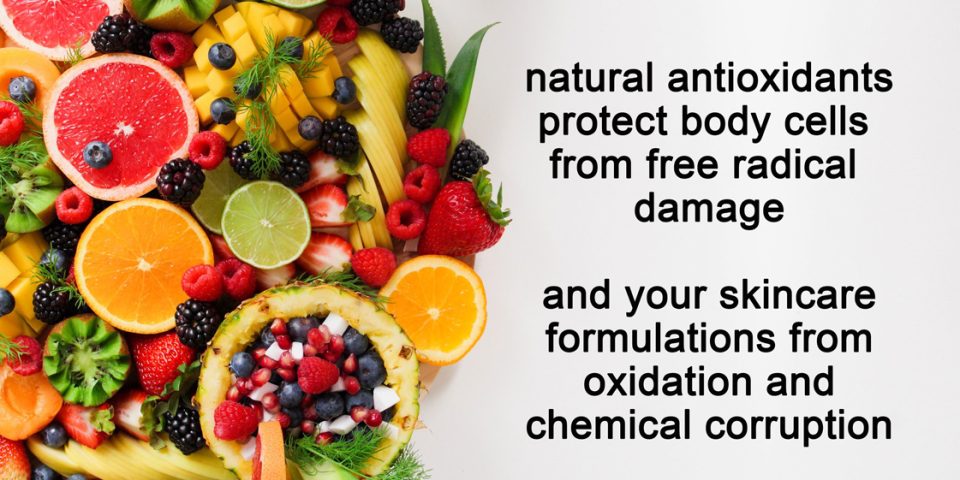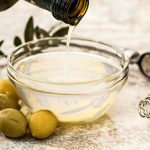Whether you are formulating skin and body care products as a DIY project for your personal and family use or for professional manufacturing of organic, natural, good-for-you products you will want to include oils, butters and waxes that have naturally occurring antioxidant properties. These antioxidant properties will prolong the shelf-life of your product and prevent early oxidation of the product rendering it useless. Once the oils in a product have oxidized, the chemical structure of the oil may become corrupted, and the original healthful benefits expected may actually provide unwanted, negative challenges to your skin and body.
| Another way to prolong the nutrients and vitamins in your skin care and body care products is to refrigerate them after open and after each use. Some individual use what is known as a cosmetic refrigerator for just such a purpose. |
An·ti·ox·i·dant, /ˌanˌtīˈäksədnt/, noun

1. a substance that inhibits oxidation, especially one used to counteract the deterioration of stored food products. 2. a substance such as vitamin C or E that removes potentially damaging oxidizing agents in a living organism.
Antioxidants are molecules that fight free radicals in your body.
Free radicals are compounds that can cause harm if their levels become too high in your body. They’re linked to multiple illnesses, including diabetes, heart disease, and cancer. Your body has its own antioxidant defenses to keep free radicals in check. However, antioxidants are also found in food, especially in fruits, vegetables, and other plant-based, whole foods. Several vitamins, such as vitamins E and C, are effective antioxidants. Antioxidant preservatives also play a crucial role in food production by increasing shelf life.
Carriers Oils, Waxes and Butters That Contain Antioxidant Properties
- Argan Oil– Argania spinosa
- Acai Oil – Euterpe olerace
- Aloe Vera Extract/Gel – Aloe Barbadensis leaf extract
- Amarnth Seed Oil – Amaranthus candatus, Amaranthus cruentus, Amaranthus hypochondriacus
- Annatto Seed Oil – atsuete Bixa orellana -aka arnatto, lipstick tree, achiote, achiotillo, bija, and urucum
- Apricot Kernel Oil – Prunus armeniaca
- Beeswax – Cera alba
- Blackberry Seed Oil – Robust fruticous
- Black Currant Seed Oil – Ribes nigrum
- Black (Cumin) Seed Oil – Nigella sativa
- Black Raspberry Seed – Rubus occidentalis
- Blueberry Seed Oil – Vaccimium corymbosum, or V. myrtillus
- Boysenberry Seed – Rubinus urbinus x idaeus
- Brazil Nut Oil – Bertholletia excels
- Broccoli Seed Oil – Brassica oleracea italica
- Calendula (Marigold) – Calendula officinalis – an infused oil usually in Olive Oil, Jojoba, Almond, Avocado, Grapeseed, Sunflower,or Meadowfoam Oils (Jojoba infusions have a shelf life of 5 years and do not require refrigeration, other infusion oils generally have a shelf-life of 6 months to a year and some up to two years.
- Camelina – Camelina sativa
- Camellia Seed – Camellia oleifera, Camellia japonica, Camellia sinensis
- Carob Pod – Ceratonia siliqua
- Carrot Seed Oil – Daucus carota – an infused oil, add it up to 15% in blends due to intense orange color which can be staining
- Cashew Nut – Anacardium occidentale
- Chaparral, Infused – Larrea tridentata
- Cherry Kernel Oil – Prunus avium
- Chia Seed Oil – Salvia hispanica
- Chufa Nut Oil – Cyperus esculentus – aka Tiger Nuts –
- Cocoa Butter – Theobroma cacao
- Coconut Oil – Cocus nucifera
- Coriander Seed Oil – Coriandrum sativum
- Cranberry Seed Oil – Vaccimium macrocarpon
- Cucumber Seed oil – Cucumis sativus
- Cupuacu Butter – Theobroma grandiflorum
- EchiumOil – Echium plantagineum – The plant itself is poisonous to grazing animals, however, the oil from the seeds is said to be nontoxic.
- Fenugreek Oil – Trigonella foenum-graecum
- Gevuina Oil, Chilean Hazelnut – Geuvina Avellana
- Goji Berry Seed Oil – Lycium Barbarum
- Grapeseed Oil – Vitus vinifera
- Hibiscus Oil – Hibiscus sabdariffa
- Kiwi Fruit Seed Oil – Actinidia Chinesis
- Maracuja Oil – Passiflora edulis, Passiflora incarnata – aka Passion Fruit Seed Oil
- Marula Oil – Sclerocarya birrea
- Milk Thistle Seed Oil – Silybum marianum
- Moringa Seed Oil – Moringa oleifera – aka Ben or Behen
- Neem Seed Oil – Azadirachta indica
- Noni Seed – Morinda citrifolia
- Oat Seed Oil – Avena sativa
- Olive Oil – Olea europaea – EVOO
- Palm Fruit Oil – Elaeis guineensis
- Papaya Seed Oil – Carica papaya
- Peanut Oil – arachis hypogeae – Vitamin E and sometimes other antioxidants are added to improve the shelf life of the oil — check the label
- Pequi Oil – Caryocar braziliensis
- Perilla Seed – Perilla frutescens, Perilla ocimoides
- Pistachio Nut Oil – Pistacia vera
- Plum Kernel Oil – Prunus domestica – Caution: The kernels of many oils pressed from the pits (Apricot, Cherry, Peach, Plum, et al.) contain cyanide. It is best to use small amounts of the oil at one time. The pits and seeds of many fruits contain amygdalin — a plant compound that your body converts to cyanide after eating.
- Pomegranate Oil – Punica granatum
- Pracaxi Oil – Pentaclethara macroloba
- Prickly Pear Oil – Opuntia ficus-indica
- Red Raspberry Seed Oil – Rubus Idaeus
- Rhatany Root Oil – Krameria lappacea, Krameria triandra
- Rice Bran Oil – Oryza sativa – rich in antioxidants, good for use in products to prevent oxidation and prolong shelf life
- Rosehip Seed Oil – Rosa mosqueta, Rosa moschata, Rosa rubiginosa,
- Rosa eglanteria – HIGH ANTIOXIDANT CONTENT
- Sacha Inchi Oil – Plukenetia volubilis – high antioxidant and skin smoothing properties make it wonderful superfood helping soothe dry, itchy, scaly, irritated skin, reduce scarring and to repair damaged hair
- Sea Buckthorn Oil – Hippophae rhamnoides – said to be the single highest source of vitamin C, vitamin E, unsaturated fatty acids, essential amino acids and beta-carotene which gives them their bright color. A notable source of phytonutrients, carotene, flavonoids, vitamin C, as well as the powerful antioxidant enzyme super-oxide dismutase, which blocks free radical damage. Perhaps best of all, they are the very best source of rare Omega 7.
- Sesame Seed Oil – Sesamum indicum, Sesamum orientale
- Strawberry Seed Oil – Fragaria ananassa, Fragaria vesca
- Sunflower Seed Oil – Helianthus annuus
- Tomato Seed Oil – Solanum lycopersicum
- Vitamin E Oil -Tocopherol, Tocotrienol
- Walnut Seed Oil – Juglans Regia
- Wheat Germ Oil – Triticum aestivum – It is an antioxidant that can be added to other carrier oils in order to extend their shelf life naturally. WARNING: high comedogenic rating and will most likely cause clogged pores and breakouts.
- Yangu, Cape Chestnut – Calodendrum capense
Grace to you and peace from God our Father and the Lord Jesus Christ. Philippians 1:2
Til next time,


References:
Antioxidants Explained in Simple Terms, By Atli Arnarson BSc, PhD — Updated on July 29, 2019, https://www.healthline.com/nutrition/antioxidants-explained#what-they-are



